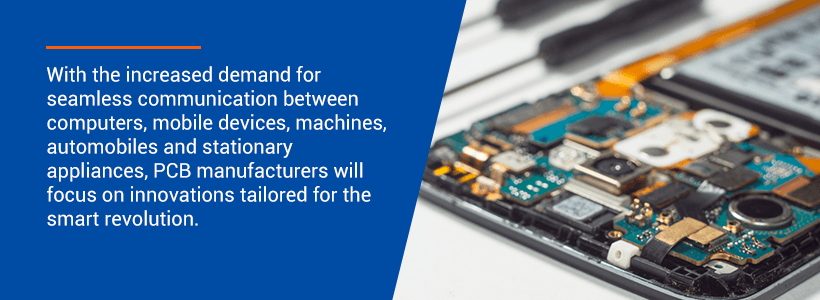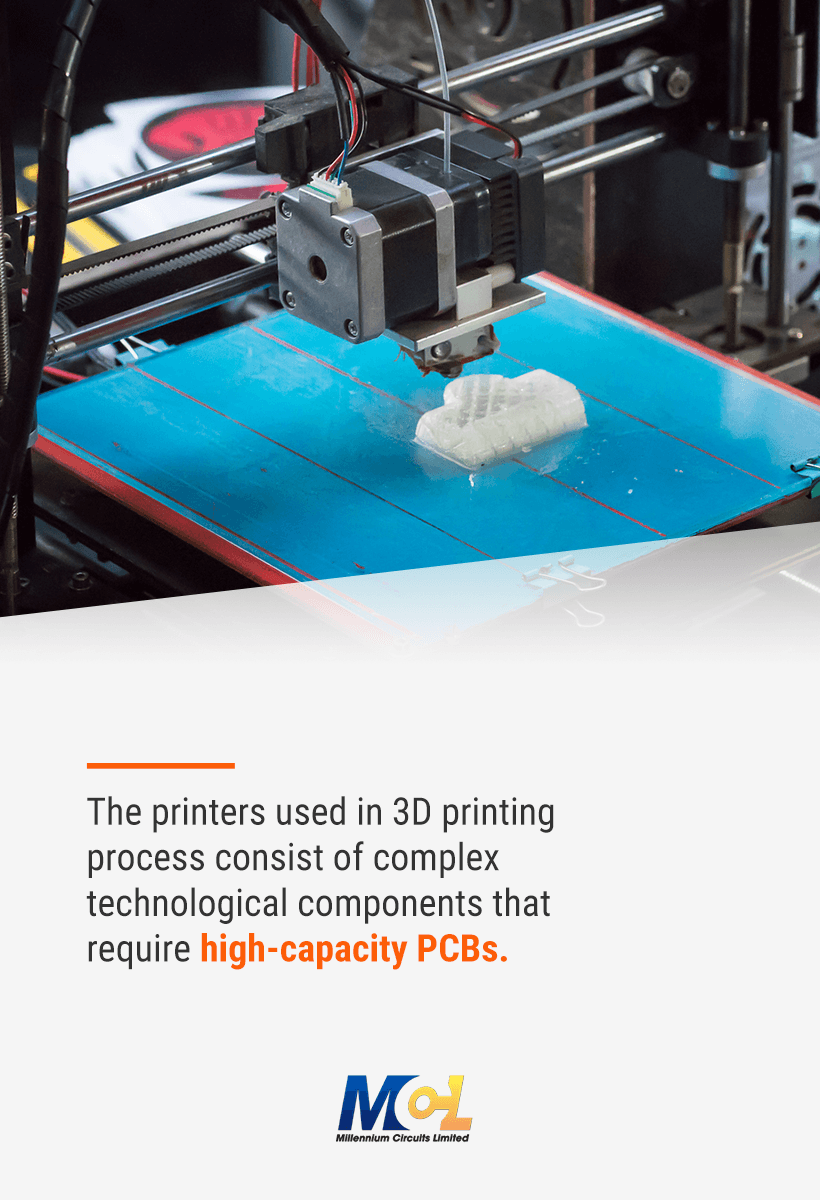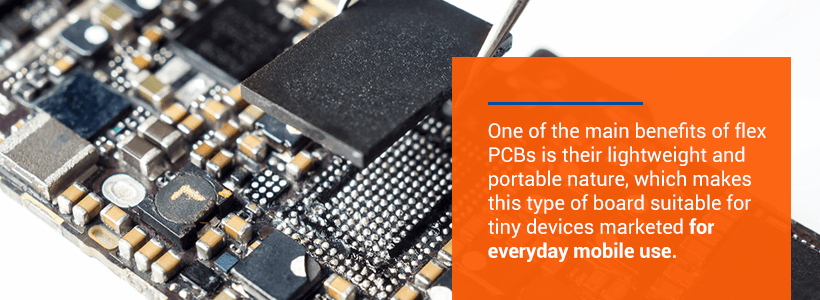Printed circuit boards, or PCBs, are constantly being improved and modified to meet the ever-growing demands of industrial electronics. Across the APAC PCB market, board manufacturers are taking special care with laminate material and signal components on double and single side PCB assemblies.
Jump To: Current PCB Trends and Market | The Future of PCBs and Expected Market Trends | Printed Circuit Boards From Millennium Circuits Limited
A regional analysis of any given sector would indicate a trend toward compact devices that require PCBs with enough flexibility and high-speed capacity to transmit unimpeded signals in virtually any setting.
The 2020s are expected to see the universal adaption of portable wireless devices as the Internet of Things, or IoT, takes over in all areas of life. By 2024, the global market for PCBs is expected to reach $70 billion. The product makers bound to witness the highest growth in business are those who can meet these demands and satisfy the rapidly changing needs of a tech-savvy public.
Current PCB Trends and Market
Trend forecasts for the early 2020s center on smaller and more flexible computing options. The push among PCB manufacturers to meet these demands has spurred certain trends within the market, like:
1. High-Density Interconnect
One of the most significant trends in the PCB market is the spread of high-density interconnect, or HDI, which was developed in response to the growing demand for faster and more compact means of interconnectivity between devices. With HDI, manufacturers can mass-produce smaller wireless products with greater routing capability and faster signal transmission.
Thanks to the power of HDI, manufacturers can now develop units with simpler PCB stackup. HDI has been developed in tandem with anti-interference technology like every layer interconnect (ELIC) and any layer interconnect (ALIC).
2. High-Power Boards
As computer technology becomes more advanced and devices require more energy and processing power, manufacturers are turning out higher-powered PCBs. Some of the latest boards operate at 48V and higher. These developments have been inspired by the spread of solar energy, as solar panels usually run on high-range energy levels. These higher-powered PCBs are essential in today’s computer devices for the mounting of battery packs. High-power boards are also more capable of resisting interference.
3. The Internet of Things
An ongoing development throughout the 2010s has been the rapid spread and increased sophistication of the Internet of Things, which combines all the devices of everyday living into an integrated network that can be remotely controlled by wireless technology.
Examples of IoT technology have been implemented in smart homes and offices. In the near future, the technology could extend to smart automobiles. To meet the challenges posed by IoT, PCB manufacturers are facing heightened security standards.
4. Flex PCBs
One of the more novel developments in printed circuit technology has been the appearance and expansion of flex PCBs, which can be bent and curled into various shapes and used in more arcane computing and wireless devices.
The development of flex PCBs has occurred in tandem with increased demand for smaller wireless devices. With flex PCBs, device makers have the potential to manufacture more compact and flexible computing products.
5. Commercial-Off-The-Shelf Components
The 2020s are expected to see a vast increase in Commercial-Off-the-Shelf, or COTS, components as increased numbers of organizations seek a more generalized set of technological solutions.
In the past, private companies sought unique and customized solutions for their business computing needs. As more and more companies operate in unconventional environments, the wide range of options and features provided by COTS are becoming a more practical option. The trend has also been encouraged by recent developments in space manufacturing.
6. Component Supply Chain Control
As organizations become more computerized and develop a need to operate remotely across vast distances, demand has increased for advanced security in technological components. One of the main objectives has been to eradicate counterfeit components from computing frameworks. To that end, PCB manufacturers are using augmented reality and virtual reality simulations during the assembly of boards and units.
The Future of PCBs and Expected Market Trends
In the 2020s, smart technology will inevitably take over certain aspects of industrial processes and everyday life. With the increased demand for seamless communication between computers, mobile devices, machines, automobiles and stationary appliances, PCB manufacturers will focus on innovations tailored for the smart revolution.
The following market trends in PCB design will extend across all corners of the public and private sectors, from industrial and business use to consumer electronics:
1. High-Density PCBs
Over the coming decade, computing technology is expected to make increased use of high-density circuit boards, also known as HDI PCBs. Due to their construction, HDIs offer a more complex array of capabilities.
HDI boards are favored for their light weight and compact size. With HDIs, product makers can attach more components on each side of a printed circuit board. As such, product manufacturers can offer smaller devices with enhanced functionality. The compact nature of HDIs has also made it possible to produce such boards in far less time than more traditional PCBs.
HDIs also offer superior electrical performance to standard boards. On HDIs, components are placed in closer proximity with increased sums of transistors. With this makeup, HDIs transmit stronger, more reliable signals and use less energy.
Pricing analyses have also shown that HDIs boost the cost-effectiveness of board manufacturing. Thanks to the compact size and reduced number of layers required for HDIs, the boards require fewer materials than standard PCBs.
2. Cameras
As cameras become commonplace among businesses throughout the commercial and industrial sector, PCBs will be enhanced to meet the new and improved features of the leading camera manufacturers.
Boards will be made to accommodate higher mega-pixel specs, and these cameras will generate optimized resolution and clarity on photographic and surveillance cameras alike. This way, businesses will be able to present photos with optimal clarity and detail for websites and brochures.
PCBs will also be designed to enhance the zoom features on the cameras of tomorrow. Before long, some of the smallest cameras on the market could have the capability to zoom in on subjects at great distances.
Improvements in PCB technology will also allow camera manufacturers to enhance the freeze-frame clarity of objects in motion. Whereas movement would typically cause blurred imagery with older cameras, today’s camera technology makes it possible to capture movement in crystal clarity.
Thanks to improved PCB components, future cameras will also be equipped with advanced filtering features that could reduce the amount of photo editing required for brochures, websites or press releases.
3. 3D Printing
Throughout the industrial sector, 3D printing is being used to produce prototypes for a range of products. In some cases, the technology is used to produce products for public use. The printers used in this process consist of complex technological components that require high-capacity PCBs. Industries that have begun implementing 3D printing include:
- Apparel: The technology for 3D printing has already been widely accepted in the apparel industry, where 3D prints are used to design prototypes of shoes, belts, handbags and jewelry.
- Automotive: 3D printing has also been used in the automotive industry to build prototypes of new models.
- Food: Some innovators in the food industry have used 3D printing to experiment with new products, such as chocolate candies, pasta and crackers.
- Aerospace: The aerospace industry has even explored the possibility of using the technology in outer space, where astronauts could produce their own food on space ships. All such productions require optimal PCB technology.
3-D printing is also being adopted in cloud-based manufacturing. This allows companies with geographically dispersed staffs to communicate via cloud servers and upload new designs from any location. For example, the moment a new design is uploaded to a company’s database in Sydney, it can immediately be printed with 3D technology at the company headquarters in New York.
4. Smart Offices and Factories
Thanks to the PCB-driven Internet of Things, computerized and automated functions will gradually take over the work environment in office spaces and pressing plants.
The revolution is already underway with numerous offices that are now equipped with technological arsenals in which computers, printers, handheld devices, surveillance cameras, HVAC systems and presentation screens are all connected to wireless systems and remotely programmable by authorized personnel.
In factories, IoT capabilities are expected to boost efficiency and aid in the rollout of automation. From a centralized computing system, engineers can control the speed and pace of conveyor belts and the intensity of each machine-powered application. Machines and tools will be manufactured with PCBs that will receive signals from these on-site computing systems.
The Internet of Things is also taking over in the retail sector, where customers can now do self-checkouts. From centralized computer systems, computer staff can control and manage a range of storewide functions, such as the activation and shutoff of lights and the regulation of air conditioners and heating systems.
5. High-Speed PCBs
The 2020s are expected to see an increased need for PCBs with physical characteristics that can maintain signal integrity in a range of high-speed environments. As products become more compact, yet high-performing and used in challenging situations, printed circuit boards are being designed to circumvent all possible problems that could cause signal delays.
In the past, board assemblers primarily paid attention to the placement of components and the basic routing pattern. Today, more consideration is placed on the width and proximity of signals. This way, newer boards are better equipped to handle issues like crosstalk, emissions, attenuation and reflections.
High-speed PCBs are built on the premise of Signal Integrity, a concept devised to work around the challenges posed by possible interference that could affect the transmission of a given signal. Whether you send a wavy analog or on/off digital signal, the transmission can be impacted by an assortment of intervening factors.
Consequently, a sent signal could ultimately yield undesirable responses, such as reflection, ringing or noise. On high-speed PCBs, each of these challenges is taken into consideration with component placements designed to meet a wider range of challenges.
6. Adaptability to Smaller Devices
The demand for smaller computing devices has led to the increasing popularity of flexible PCBs, which can be assembled to accommodate virtually any type of design. The trend has also been spurred by the need for PCBs that have the flexibility to withstand a wider range of operating conditions. With flexible PCBs, manufactures can fit boards into odd-shaped devices, and also design products for hotter and more extreme environments.
One of the main benefits of flex PCBs is their lightweight and portable nature, which makes this type of board suitable for tiny devices marketed for everyday mobile use. The flexibility of the base material makes PCBs in this category better suited for high-stress situations, plus uses that consist of rapid movements in random directions.
Prior to the introduction of flexible PCBs, product manufacturers often had to modify their design ideas to the range of shapes and dimensions that could be accommodated by rigid circuit boards.
Consequently, product makers were unable to produce devices that offered the same kind of portability and high-stress operability as some of today’s products. Now, the dynamic has reversed because flex PCBs make it possible for product makers to modify boards to conform to the needs of a given device.
7. BiodegradablePCBs
Biodegradable PCBs have been made possible with the use of natural fibers derived from fruit matter and wheat gluten. Banana stems, for example, contain fibers that can naturally decompose, yet can also be used for PCBs when mixed with properties suited for electronics. In the upcoming years, boards made with biodegradable products are likely to spread throughout the computing industry and industrial sector.
The move toward biodegradable PCBs has been driven by the need to cut down on tech waste at dumping sites. For many years, PCBs would simply go to waste once the components got outmode by newer technology.
While computer cases and other metal components could simply be recycled, PCBs would simply end up in dumpsters. Thanks to the advent of biodegradable PCBs, companies can reduce their carbon footprint by dispensing with boards the natural way.
PCBs have traditionally been made of fire-resistant plastics that consist of products that cannot decompose, such as epoxy and glass fiber. Fortunately, composites made of wheat gluten and banana fibers yield dielectric constants that are within the acceptable range for electronic devices.
Printed Circuit Boards From Millennium Circuits Limited
PCB innovations are expanding at an ever-rapid rate to meet the heightened demands of the industrial and commercial sectors. In order to keep your products up to speed with these demands, it’s essential to have PCBs with the flexibility and high-speed capacity to work in a vast range of compact devices and perform flawless IoT transmission.
At Millennium Circuits Limited, we offer a wide array of PCBs to organizations around the world. Headquartered in Harrisburg, Penn., we supply flex and rigid PCBs with domestic and international transmission capacity. Contact Millennium Circuits Limited to get a quote on our PCB products, specials and services.






